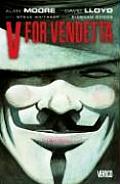“The utter eradication of thought balloons”
Once established (as discussed yesterday), thought balloons became a valuable way that comics creators could “show the invisible,” which I posit is a dimension that sets that form apart from other types of illustrations. That was especially useful when there was a contrast between a character’s thoughts and his actions or speech, as with Cerebus or Peter Parker.
Too often, however, comics creators used thought balloons to tell rather than show, especially for the benefit of young readers and those who had never, ever seen a comic before: “Oh, no! Once again my ring won’t work against anything yellow! I must think of something else before...” (I exaggerate, but only a little.)
In the early 1980s, artist David Lloyd and writer Alan Moore were discussing a new feature for the magazine Warrior in their native Britain. This was meant to be a more sophisticated adventure for adult readers, and its main character’s plans and motives were opaque. Moore wrote of that planning:
Meanwhile, a bunch of American comics creators, including Marv Wolfman, John Byrne, and Frank Miller, were experimenting with first-person narration in captions instead of third-person narration. Those captions offered a space for internal monologue separate from thought balloons. The popularity of the results, particularly Miller’s Ronin and Dark Knight Returns, worked with Watchmen and V for Vendetta to make thought balloons seem unsophisticated. And soon they were utterly eradicated.
Too often, however, comics creators used thought balloons to tell rather than show, especially for the benefit of young readers and those who had never, ever seen a comic before: “Oh, no! Once again my ring won’t work against anything yellow! I must think of something else before...” (I exaggerate, but only a little.)
In the early 1980s, artist David Lloyd and writer Alan Moore were discussing a new feature for the magazine Warrior in their native Britain. This was meant to be a more sophisticated adventure for adult readers, and its main character’s plans and motives were opaque. Moore wrote of that planning:
Dave was giving me his ideas as to how he actually wanted to approach the strip in terms of layout and execution. These included the absolute banning of sound effects, and, as an afterthought, the utter eradication of thought balloons into the bargain.The result was V for Vendetta, and a more cinematic approach to comics storytelling. There may well be earlier examples of mainstream comics creators deliberately doing without so many of their standard narrative tools, but this approach was most influential. That’s because Moore, getting over his initial reluctance, embraced the approach and carried it with him to Watchmen.
As a writer, this terrified me. I wasn’t so much bothered about the sound effects, but without thought balloons, how was I going to get over all the nuances of character that I needed to make the book satisfying on a literary level? All the same, there was something about the discipline of the idea that fascinated me, and while dropping off to sleep at night I’d find it nagging away somewhere in the recesses of my cerebral swamp.
A couple of days later I wrote back to Dave telling him...that not only would we do without thought balloons and sound effects but I was prepared to get rid of most of the caption boxes as well and just rely entirely on pictures and dialogue.
Meanwhile, a bunch of American comics creators, including Marv Wolfman, John Byrne, and Frank Miller, were experimenting with first-person narration in captions instead of third-person narration. Those captions offered a space for internal monologue separate from thought balloons. The popularity of the results, particularly Miller’s Ronin and Dark Knight Returns, worked with Watchmen and V for Vendetta to make thought balloons seem unsophisticated. And soon they were utterly eradicated.



No comments:
Post a Comment